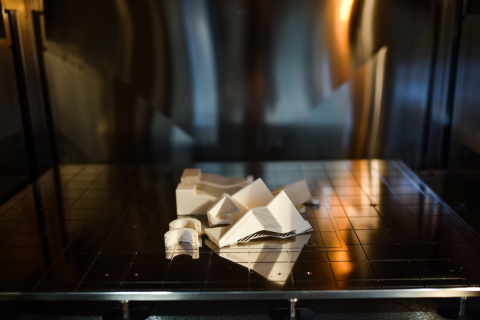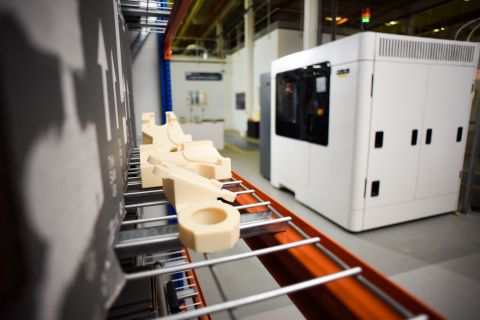UK-based aerospace supplier GKN Aerospace has improved tooling production times by deploying an additive manufacturing solution from Stratasys at its Filton, UK, manufacturing plant.
The company has deployed the Stratasys F900 Production 3D Printer to reduce lag times for making production line tools and to create complex parts that would otherwise be impossible to fabricate with other types of manufacturing approaches.
 GKN is printing tooling on the Stratasys F900 Production 3D printer. Image courtesy of Stratasys/Businesswire.
GKN is printing tooling on the Stratasys F900 Production 3D printer. Image courtesy of Stratasys/Businesswire.“Since integrating the F900, we have dramatically reduced production line downtime for certain teams and are enjoying a new found freedom to design complex tools,” says Tim Hope, Additive Manufacturing Center Manager at GKN Aerospace.
According to GKN, the lead time typically required to produce a metal or plastic replacement tool is several weeks. With a 3D printer in the facility, the company can more quickly produce tools that are better suited to its operational needs.
 3D printing allows GKN to product fixtures and tooling that would be impossible to create with traditional methods. Image courtesy of Stratasys/Businesswire.
3D printing allows GKN to product fixtures and tooling that would be impossible to create with traditional methods. Image courtesy of Stratasys/Businesswire.“We can now cost-effectively produce tools for our operators within three hours,” Hope explains. “This saves critical production time, and by printing in engineering-grade thermoplastics, we can produce 3D printed tools with repeatable, predictable quality every time. All while matching the quality of a traditionally-produced tool, and reducing the costs and concessions compared to equivalent metallic tooling.”
In addition, the company reports that material waste has decreased by 40% with the new system. Hope says that the use of 3D printing has also provided more flexibility regarding tool design.
“One of the key benefits of additive manufacturing is the creative freedom this technology affords users,” explains Hope. “The F900 offers the largest build-size of any FDM 3D printer, enabling us to rapidly produce tools to meet any requirements. Most notably, complex geometries and cavities that would otherwise be problematic are now practical with the F900. We’re utilizing it to design, and 3D print, previously inconceivable tools that enable us to manufacture complex parts that are uneconomical or just physically impossible by other methods.”
GKN is currently using a standard thermoplastic for the application, but is also testing Stratasys’ high-strength, heat-resistant ULTEM 1010 Resin material as well.
GKN is heavily involved in additive manufacturing, and recently received a contract from ArianeGroup (Airbus and Safran) to develop and additively manufacturing two turbines for a reusable rocket engine called Prometheus. Ground tests for that methane engine will take place in 2020.
GKN reported that the use of 3D printing would reduce the number of turbine parts from 100 to two, which significantly lowered costs.
Source: Stratasys
About the Author
Follow Robotics 24/7 on Linkedin
Article topics
Email Sign Up















